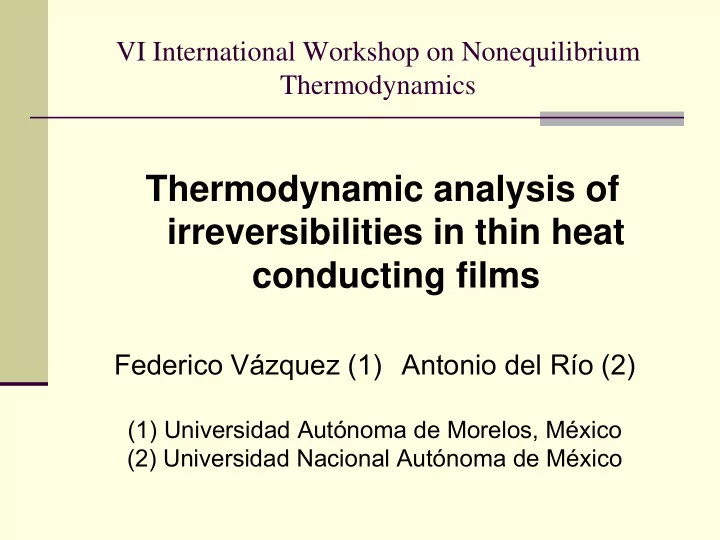

VI International Workshop on Nonequilibrium Thermodynamics Thermodynamic analysis of irreversibilities in thin heat conducting films Federico Vázquez (1) Antonio del Río (2) (1) Universidad Autónoma de Morelos, México (2) Universidad Nacional Autónoma de México
Outline Motivation Heat transport models for thin films The diffusive-ballistic transition. Power spectrum of temperature fluctuations Power spectrum of heat flux fluctuations Thermodynamic susceptibility Entropy production Group and phase velocity Comments and conclusions
Motivation In small electronic structures heat is generated in a concentrated way which causes high temperatures operation This can affect their performance and reliability. Yet little has been done to analyze entropy generation in solids at length scales comparable with or smaller than the mean free path of heat carriers
A fundamental knowledge of the entropy generation processes provides a thermodynamic understanding of heat transport in solid structures this is particularly important for the performance evaluation of thermal systems and microdevices
del Río et al., PRE 2004.
Vázquez et al., Entropy 2011.
Heat conducting film q·n - q·n
Effects of size reducing A) Heat transport is no longer described by Fourier law (large space-time scales) Other models (Cimmelli, JNET 2009): Cattaneo Guyer and Krumhansl … B) K depends on size
A) Heat transport model Limiting cases
Crossover from diffusive to ballistic heat transport Generalized heat conductivity (Jou et al. AML 2005) Properties a generalized heat conductivity Or (Chen, J. Heat Transfer 2002).
Heat transport models linking diffusive and ballistic regimes Ballistic-diffusive equations (Chen, J. Heat Transfer 2002). given by solutions of Boltzmann´s equation
Lebon et al. model (Lebon et al., Proc. R. Soc. A 2011). Cattaneo Guyer and Krumhansl
The C-F- model (Anderson and Tamma, PRL 2006).
GENERIC (Öttinger and Grmela, PRE 1997) Mesoscopic view Gas of phonons State variable: one-phonon distribution function Two level description for small systems State variables: energy density, heat flux and one-phonon distribution function GENERIC Chen’s equations plus non linear terms and terms involving gradients Grmela et al., APL 2005.
B) K dependent on size Extended Irreversible Thermodynamics Dynamics of higher order fluxes
Size dependent heat conductivity Stationary state, k=2 π /L Jou et al., APL 2007
In favor of the use of K(Kn) in the transport equations: Jou et al., APL 2007 FIG. 2. Evolution of the heat flux through the x =0 wall in a device with Knudsen number of 10. The dashed line represents the Fourier law, the solid line is the Maxwell-Cattaneo equation, the dotted line is the EIT equation, and the dash- dotted lines are Chen model Ref. 19 and model by Joshi and Majumdar Ref. 4.
We use C-F model Fourier Cattaneo + and Model parameter
Jeffrey like model C-F model is a -correlated function with zero mean. with
Jeffrey’s equation has been obtained from different theoretical schemes Double-lag method (Tzou, 1997), Extended Irreversible Thermodynamics (Jou et al. 2011), Internal variables formalism (Mauguin, 1990), Kernel (Joseph and Preziosi, 1989)
Jeffrey’s model and the ballistic- diffusive transition
Temperature equilibrium fluctuations FD Theorem Power spectrum
Power spectrum of temperature fluctuations Jeffrey’s like model As a function of Kn (Knudsen number) and frequency. Red line corresponds to Kn = 0.2 (diffusive transport) and the black one to Kn = 2.5 (wave propagation). The WP − DT transition occurs at Kn = 2.3 and FT = 0.1. The material is Silicon.
Power spectrum of temperature fluctuations Jeffrey’s like model Blue kn=1>knt (ballistic), red kn=0.38<knt (diffusive), knt=0.43.
Diffusive transport and wave propagation Physical meaning of the maxima: They appear at If one maximum exists. Other case: There exists propagation of thermal waves with velocity Transition Knudsen number: For the transport of thermal signals is diffusive and ballistic otherwise.
Autocorrelation function of temperature fluctuations Jeffrey’s like model As a function of Kn (Knudsen number) and delay time. Red line corresponds to Kn = 0.2 (diffusive transport) and the black one to Kn = 2.5 (wave propagation). The WP − DT transition occurs at Kn = 2.3 and FT = 0.1. The material is Silicon.
Summary Transition Fourier NO 1 Cattaneo YES 0 Jeffrey --- YES Guyer-Krumhansl NO ---
Power spectrum of heat flux equilibrium fluctuations Transition can not be seen. Jeffrey’s like model Blue kn=l/L, red kn=l/(1.2L), yellow kn=l/(1.5L)
Power spectrum of heat flux fluctuations vs. Knudsen number Jeffrey’s like model
Spectral thermodynamic susceptibility vs. Knudsen number ballistic diffusive Hz Hz Hz Hz Transition can not be seen. Jeffrey’s like model =0.27
Entropy production Compatibilidad termodinámica Álvarez et al., PRE 2008
In the stationary state: Entropy production in the volume:
Entropy production in stationary state vs. Knudsen number ballistic diffusive Diamond, =0.27 Jeffrey’s like model
Equation of phonon radiative transfer results Bright, J. Heat Transfer 2010
Group velocity of propagating Fourier modes ballistic diffusive
Phase velocity of propagating Fourier modes Jeffrey’s like model ballistic diffusive
Inverse of phase velocity of propagating modes ballistic diffusive Jeffrey’s like model Gámbar and Márkus, PLA 2007
Conclusions When the size of the film is reduced, the Kn=1 crossover shows 1) A transition in the power spectrum of temperature fluctuations 2) A transition in the autocorrelation function of temperature fluctuations 3) A quick increasing of the entropy production when Kn 1 4) A regime of high entropy production when Kn 5) The features of a dynamical phase transition
Thank you! vazquez@uaem.mx
Recommend
More recommend